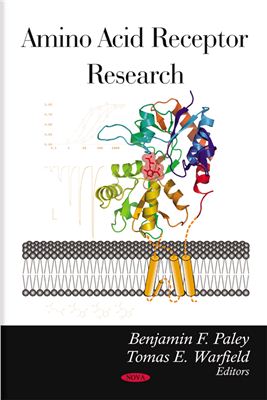Nova Science Publishers. 2008. 475 p.
Amino acid receptors and cell surface proteins that bind amino acids and trigger changes which influence the behaviour of cells. Glutamate receptors are the most common receptors for fast excitatory synaptic transmission in the vertebrate central nervous system, and GAMMA-AMINOBUTYRIC ACID and glycine receptors are the most common receptors for fast inhibition. This book presents the latest research in the field.
Contents
Interactions between Ligand-Gated Ion Channels: A New Regulation Mechanism for Fast Synaptic Signaling?
A Rapid and Efficient Protocol for Transfecting NMDA Receptor Channels into Mammalian Cells
Glutamate Receptors in the Retina: Neurochemical and Developmental Aspects
Peripheral Glutamate Signalling, Immunity and Pain: Novel Aspects in Psychoneuroimmunology
Insights from Structure-Function Studies of AMPA Receptor Agonists and Competitive Antagonists
Glutamate Signalling in the Skin
Regulatory Mechanism of Plasticity at GABAA Receptor-Mediated Inhibitory Synapses
GABAAR Lateral Mobility and Localization
The Role of NMDA Glutamate Receptors in Pain and Anesthetic-Induced Neurodegeneration during Development
Spinal Processing of Pain: A Review on NMDA Receptor-Mediated Activation of Arachidonic Acid and Nitric Oxide Signalling
Fragrant Compounds in Foods and Beverages Enhance the GABAA Receptor Responses
AMPA Receptor-Mediated Neuronal Death in Motor Neuron Disease
Glutamate Receptors Involved in the Interaction between Peripheral Nerve Terminals
Excitotoxicity and White Matter Damage
Regulation of Synaptic Transmission and Brain Function by Ambient Extracellular Glutamate
Glutamate and Ethanol: The Role of the Ionotropic NMDA Glutamate Receptors in Alcoholism
Chemoreception of Umami in Caterpillars
Glutamate Synapses in Olfactory Neural Circuits
Amino acid receptors and cell surface proteins that bind amino acids and trigger changes which influence the behaviour of cells. Glutamate receptors are the most common receptors for fast excitatory synaptic transmission in the vertebrate central nervous system, and GAMMA-AMINOBUTYRIC ACID and glycine receptors are the most common receptors for fast inhibition. This book presents the latest research in the field.
Contents
Interactions between Ligand-Gated Ion Channels: A New Regulation Mechanism for Fast Synaptic Signaling?
A Rapid and Efficient Protocol for Transfecting NMDA Receptor Channels into Mammalian Cells
Glutamate Receptors in the Retina: Neurochemical and Developmental Aspects
Peripheral Glutamate Signalling, Immunity and Pain: Novel Aspects in Psychoneuroimmunology
Insights from Structure-Function Studies of AMPA Receptor Agonists and Competitive Antagonists
Glutamate Signalling in the Skin
Regulatory Mechanism of Plasticity at GABAA Receptor-Mediated Inhibitory Synapses
GABAAR Lateral Mobility and Localization
The Role of NMDA Glutamate Receptors in Pain and Anesthetic-Induced Neurodegeneration during Development
Spinal Processing of Pain: A Review on NMDA Receptor-Mediated Activation of Arachidonic Acid and Nitric Oxide Signalling
Fragrant Compounds in Foods and Beverages Enhance the GABAA Receptor Responses
AMPA Receptor-Mediated Neuronal Death in Motor Neuron Disease
Glutamate Receptors Involved in the Interaction between Peripheral Nerve Terminals
Excitotoxicity and White Matter Damage
Regulation of Synaptic Transmission and Brain Function by Ambient Extracellular Glutamate
Glutamate and Ethanol: The Role of the Ionotropic NMDA Glutamate Receptors in Alcoholism
Chemoreception of Umami in Caterpillars
Glutamate Synapses in Olfactory Neural Circuits

